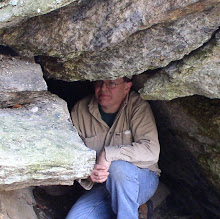This time around, it was six days out. Primarily stationed on Cape Ann, but per usual, visits along the way in - and out - took place.
Entrance to the old mine.
First up was a very old silver mine up in Middlesex County. Upon arrival, I quickly discovered exploration would require more equipment than I usually carry. However, the entrance area was photographed before moving on and leaving it for a future visit.
Day Two saw kayaking out of Lanes Cove and down (south) the coast, reaching my goal of Lobster Cove right about high tide. An interesting area, which is more of a long and relatively narrow inlet. But a good chance to check out the exposed granites along the shoreline, as well as a few large erratics. Off shore winds that persisted during my stay, made for choppy going on the water, therefore this was the only opportunity I had to use the kayak on this trip. Later in the day towards low tide, I was able to make my way out to Salt Island plus visit a small sea cave along the Gloucester mainland.
Small sea cave (sea spout) along the Gloucester shore
The next three days involved a pretty extensive exploration of some the area's prime woodlands and hiking areas. Days three and four covered sections of a trail network near the Essex - Manchester town lines. First time out was an old mill site, Pulpit Rock (and a near by marginal cave), the Bishop's Grave, and finally the Bear's Den. The next day covered an extensive area I had not seen before: southern parts of the old Manchester to Essex Road, Baby Rock, and Ship Rock. Along the way a generous number of glacial erratics, perched boulders, and towering outcrops of granite, showed themselves.
Baby Rock
The fifth day took me back in to Dogtown to explore a section of woods not previously seen. This trail ran along a high ridge with numerous glacial erratics before turning more inland, where I eventually ended my journey at Racoon Rocks. Later on, I trucked up to Rockport in an effort to find trail access to it's central woodland sections. Although, this proved unsuccessful, I did stumble upon a huge deposit of glacial boulders, somewhat reminiscent of Racoon Rocks.
My final day on the road saw me cover a site in Middlesex County on an old postcard displaying a large boulder in a local cemetery. Then on to Estabrook Woods in Concord to look over an old lime mining site, the dilapidated remains of an old kiln, and Indian Rock. The Rock has a pretty impressive circumference of 60 feet with heights averaging 5 to 7 feet.
Dropping down to Route 2 allowed me to travel the good old Mohawk Trail all the way west to Shelbune before turning south for the last leg of my journey home.


















































